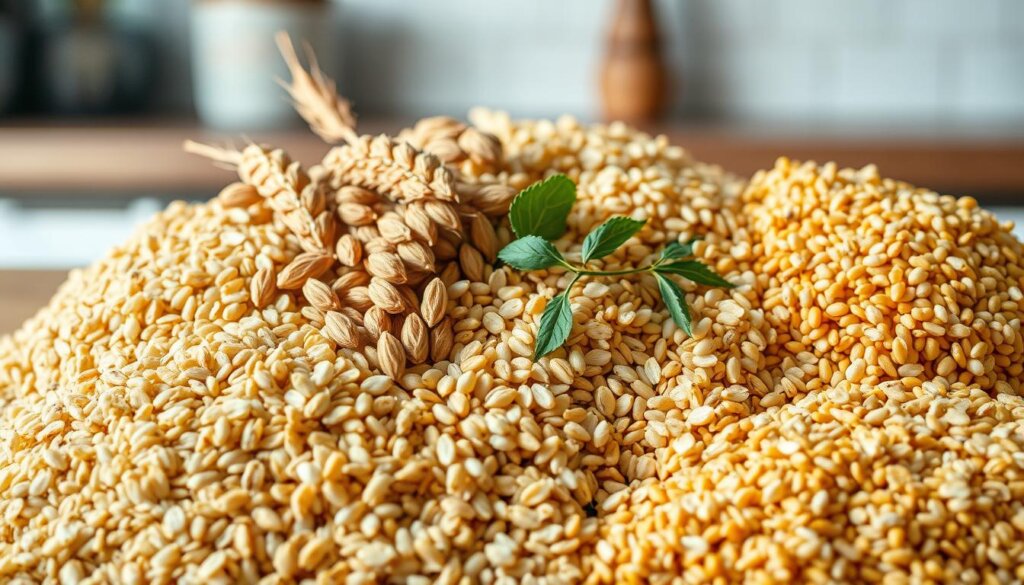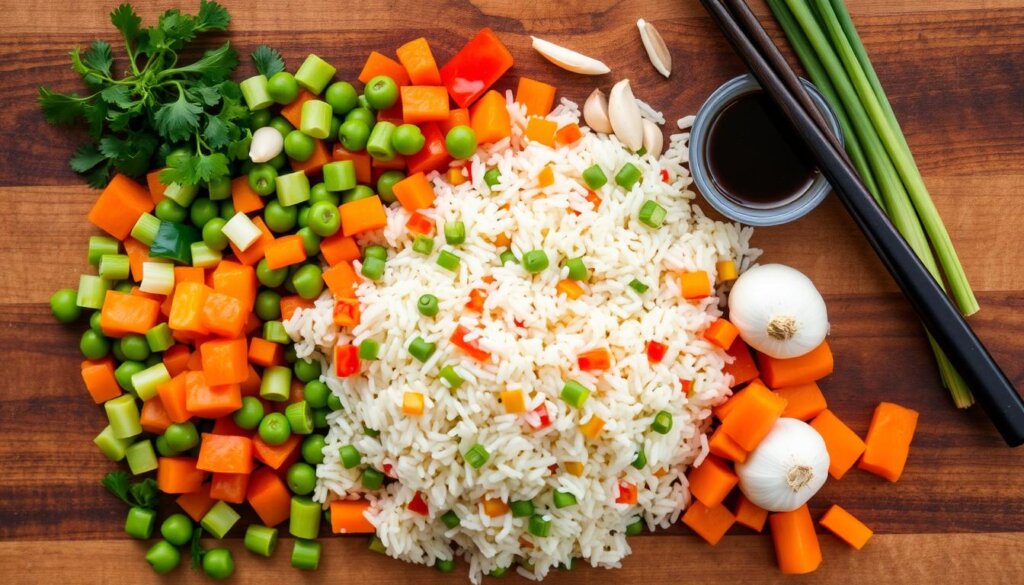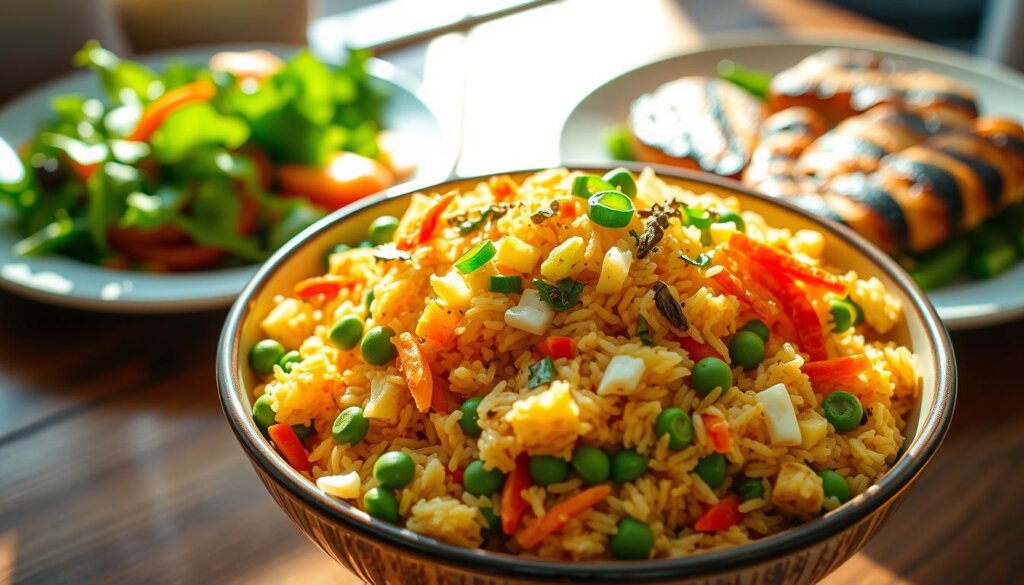Ever thought about whether your favorite fried rice is gluten-free? With gluten sensitivity affecting about 13% of the world’s population, it’s crucial to know what’s in your food. Traditional fried rice often includes soy sauce, which typically contains gluten, making it a potential concern for those with dietary restrictions.
The key to safe fried rice lies in choosing the right ingredients. Opt for tamari or gluten-free soy sauce, and pair it with fresh veggies and proteins for a safe, delicious meal.
For more gluten-free meal ideas, explore Gluten-Free Chicken Stir-Fry, Easy Shrimp Quesadilla, or Gluten-Free Tuna Casserole. Enjoy fried rice without the gluten worry!
Table of contents
Understanding Gluten and Its Sources
Knowing about gluten is key for those with dietary limits. The gluten definition is about proteins in grains like wheat, barley, and rye. These proteins help baked goods keep their shape.
While many love gluten-rich foods, some struggle to digest them.
What is Gluten?
Gluten has two main proteins: gliadin and glutenin. These proteins make dough stretchy. You’ll often find gluten in wheat flour, bread, and pasta.
Knowing where gluten is in your food is important, mainly for health reasons.
Why is Gluten a Concern?
About 13% of people worldwide have gluten sensitivity. It can cause bad symptoms. For those with celiac disease, gluten attacks the small intestine.
Three million Americans have celiac disease. Others might feel sick from gluten without celiac disease. Knowing gluten’s effects can help you eat better.

Being aware of gluten and where it comes from helps you eat well. Foods like quinoa, corn, and millet are gluten-free and nutritious. Legumes are great for replacing rice in meals, adding variety to your diet.
For more on gluten and how it affects health, see this link on gluten-free options.
Is Fried Rice Gluten-Free?
Whether fried rice is gluten-free depends on its ingredients. Traditional fried rice has cooked rice, veggies, eggs, and protein like chicken or tofu. But, soy sauce is often used, which has wheat and is not good for those with gluten intolerance.
Traditional Ingredients in Fried Rice
Traditional fried rice recipes include:
- 3 cups cooked, cooled jasmine or basmati rice
- 1 cup diced red bell pepper
- 1 cup diced carrots
- 1/2 cup frozen peas
- 1/2 cup frozen corn
- 2 green onions
- 1 teaspoon fresh ginger
- 1-2 cloves garlic
- 2 Tablespoons avocado oil or olive oil
- 3-4 Tablespoons gluten-free tamari
- 1/2 Tablespoon toasted sesame oil
- Black or white pepper
To make fried rice gluten-free, avoid regular soy sauce. Use gluten-free soy sauce or tamari instead. This keeps the dish tasty and safe for those with gluten issues.
How to Make Fried Rice Gluten-Free
Making gluten-free fried rice is easy. Just follow these steps:
- Begin with cold, cooked rice that’s been chilled for 1 to 2 days for the best texture.
- In a skillet, heat 1 Tablespoon of oil over medium heat. Scramble the eggs and set them aside.
- Add another Tablespoon of oil to the skillet. Then, sauté ginger and garlic for 1 minute.
- Put in the diced veggies and cook until they’re tender, about 4-5 minutes.
- Add the cold rice and mix well, breaking up any clumps.
- Mix in the scrambled eggs, gluten-free soy sauce, and toasted sesame oil.
- Season with black or white pepper. Stir well to distribute evenly.
- Finish by garnishing with green onions before serving.
Using gluten-free ingredients ensures safety for those with dietary restrictions. Leftover fried rice can be stored in the fridge for up to 3 days. Reheat it in a skillet or microwave. Each serving of gluten-free fried rice has about 267 calories, with a good mix of protein, carbs, and vitamins.

Health Benefits of Fried Rice
Fried rice is more than a tasty dish. It’s full of health benefits when made with good ingredients. It’s packed with vitamins, minerals, and proteins, making it great for a balanced diet.
Nutritive Value
Rice is a key part of fried rice, important for half the world’s people. Brown rice has more protein and fiber than white rice. It helps with digestion and keeps you full.
Adding veggies makes fried rice even better. They add antioxidants and minerals. Garlic and ginger also boost its nutritional value, making it a healthy choice.

Protein Sources
Adding protein to fried rice makes it even better. Eggs, chicken, or tofu add flavor and amino acids. They help repair and build muscles, which is great with chicken.
For vegans, tofu is a great protein source. Adding these proteins makes fried rice a complete meal. It’s perfect for keeping hunger away while meeting dietary needs.
| Ingredient | Calories (per 100g) | Protein | Fiber |
|---|---|---|---|
| White Rice (cooked) | 131 kcal | 2.8g | 0.5g |
| Brown Rice (cooked) | 132 kcal | 3.6g | 1.5g |
| Chicken Breast (cooked) | 165 kcal | 31g | 0g |
| Tofu (firm) | 144 kcal | 15g | 0.3g |
Who Should Avoid Fried Rice?
Fried rice is loved by many, but some should be careful. Health issues and dietary rules can affect who eats it. Knowing what’s in fried rice helps you make smart choices.
Health Considerations
People with celiac disease or gluten sensitivity can’t have fried rice with regular soy sauce. It has gluten. Those with high blood pressure should watch their sodium intake from fried rice. Diabetics and those on low-fat diets need to check the ingredients closely.
Other Dietary Restrictions
Some have allergies to fried rice ingredients. Those allergic to eggs should avoid egg-based fried rice. Soy allergy sufferers need to pick soy sauce substitutes like tamari or coconut aminos. Shellfish allergies, like from shrimp, are also important.
For vegans, it’s key to check for animal products. Choose modifications that fit your diet.
| Dietary Consideration | Recommended Actions |
|---|---|
| Celiac Disease/Gluten Sensitivity | Avoid soy sauce with gluten. Choose gluten-free alternatives. |
| High Blood Pressure | Limit sodium intake by decreasing soy sauce or using low-sodium options. |
| Diabetes | Modify ingredients for lower carbs; consider the type of rice used. |
| Egg Allergy | Choose egg-free fried rice options. |
| Soy Allergy | Use tamari or coconut aminos instead of regular soy sauce. |
| Shelfish Allergy | Skip shrimp or use alternative proteins. |
| Vegan Diet | Ensure no animal products are included; opt for vegetable proteins like tofu. |
Conclusion
Fried rice can be gluten-free if you choose the right ingredients and cooking methods. Use gluten-free soy sauce instead of regular soy sauce. This makes fried rice safe for those who can’t eat gluten.
Be careful about cross-contamination. Gluten can get into white rice during harvesting or processing. This is why it’s important to use gluten-free rice.
Fried rice is good for you, full of veggies and proteins. It’s a great choice for those who can’t eat gluten. It’s also tasty and healthy.
Make sure to use certified gluten-free rice and fresh ingredients. This way, you can enjoy fried rice without worrying about gluten. It’s perfect for any meal, adding flavor and nutrition.
Learn more about the gluten-free properties of white rice.
FAQ
Is fried rice gluten-free?
Fried rice can be gluten-free. It depends on the soy sauce used. Use tamari instead of regular soy sauce for those with gluten sensitivities.
What makes fried rice not gluten-free?
Fried rice may not be gluten-free if it includes soy sauce made with wheat or other gluten-containing ingredients like certain seasonings, broths, or marinades.
What are the traditional ingredients in fried rice?
Fried rice has cooked rice, veggies, eggs, and protein like chicken or tofu. But, soy sauce often has gluten, so it’s important to choose gluten-free options.
How can I make fried rice gluten-free?
Use gluten-free soy sauce or tamari. Make sure the rice is gluten-free. Clean your cooking area well to avoid gluten.
What health benefits does fried rice offer?
Fried rice is full of carbs for energy. It also has vitamins and minerals from the veggies.
Can you eat Chinese if gluten-free?
Yes, you can eat Chinese food if you’re gluten-free, but you need to choose dishes carefully. Look for plain steamed rice, rice noodles, and vegetable or meat dishes made without soy sauce or wheat-based thickeners. Always ask about preparation methods to avoid cross-contamination.
What Chinese rice is gluten-free?
Plain steamed rice, jasmine rice, and fried rice made without gluten-containing ingredients (like soy sauce with wheat) are gluten-free options. Always verify how the rice is prepared to ensure it is safe.





